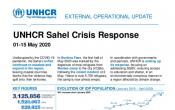Mali
Operation: Mali
Location
{"longitude":-2,"latitude":17,"zoom_level":0,"iso_codes":"'MLI'"}
By clicking on the icons on the map, additional information is displayed.
The boundaries and names shown and the designations used on this map do not imply official endorsement or acceptance by the United Nations.
Key Figures
| 2020 planning figures | |
| 100% | of returnees’ reintegration is made more sustainable |
| 100% | of people of concern will be registered on an individual basis |
| 100% | of targeted households will have basic needs met with multi-purpose cash grants or vouchers |
| 100% | of refugees living in Mali with intention to return will return voluntarily |
| 100% | of identified people of concern in need of resettlement will be submitted for resettlement |
| 2018 year-end results | |
| 100% | of facilitated voluntary return was carried out in safety and dignity |
| 77% | of new born babies received birth certificates |
| 75% | of local law and policy relating to internal displacement in line with international standards |
| 41.3% | of persons of concern between 18-59 years old had their own business or are self-employed for more than 12 months |
| 550 | refugee and host community households received multi-purpose cash grants |
Latest Updates
People of Concern
79%
Increase in
2019
2019
| 2019 | 275,779 |
| 2018 | 154,432 |
| 2017 | 84,081 |

[["Refugees",26670],["Asylum-seekers",1008],["IDPs",207751],["Returned IDPs",35101],["Returned refugees",5249]]
Loading ...
Mali
< Back
2019
{"categories":[2015,2016,2017,2018,2019,2020],"budget":[67.860516734,49.1719132,41.007531648,21.59999173,17.33224968,47.50161438],"expenditure":[14.86664134,13.37227655,13.34678074,13.35314797,13.1037125,null]}
{"categories":[2015,2016,2017,2018,2019,2020],"p1":[48.924988312,27.08867361,13.625051768,11.21245007,8.28224972,24.87619908],"p2":[0.12311877,1.06694838,0.956948,null,null,null],"p3":[10.754399482,17.77571883,25.28018688,9.26252293,7.44999949,9.27332685],"p4":[8.05801017,3.24057238,1.145345,1.12501873,1.60000047,13.35208845]}
{"categories":[2015,2016,2017,2018,2019,2020],"p1":[9.3844582,7.040851,5.73030234,7.10949783,6.54075124,null],"p2":[0.10197148,0.57564893,0.75438523,null,null,null],"p3":[3.67058966,4.66259468,6.39414574,5.46708624,5.30093182,null],"p4":[1.709622,1.09318194,0.46794743,0.7765639,1.26202944,null]}
Loading ...
CHOOSE A YEAR
- 2014
- 2015
- 2016
- 2017
- 2018
- 2019
- 2020
Operational environment
The operational environment in Mali is expected to continue volatile in 2019. Terrorism, crime and violence remain major constraints, coupled with intercommunal clashes likely due to lack of basic social services and inequitable access to justice.The estimated number of people of concern in Mali in 2019 stands at 89,000, including some 24,400 refugees. The majority of refugees are from Mauritania (15,300), followed by Burkina Faso (7,400) and smaller numbers from the Central African Republic, Côte d’Ivoire and the Democratic Republic of the Congo. The number of IDPs is expected to be some 62,600, majority displaced due to ethnic violence, incidents with armed groups and the interventions of G5 Sahel forces.
Despite instability, Mali remains hospitable to asylum-seekers and refugees. Asylum-seekers have access to refugee status determination procedures and receive government certificates that protect them from unlawful detention and expulsion, while recognized refugees receive five-year renewable identity cards. Moreover, the Government of Mali is favourable to naturalization for long-term refugees and the inclusion of people of concern into its national development programmes.
Developing strategic partnerships is one of UNHCR’s key priorities for 2019. UNHCR is involved in the development of the 2019-2022 Cadre strategique pour la Relance Economique et le Développement Durable du Mali (CREDD) and the 2020-2023 UNDAF+ to ensure policy coherence between these plans and the 2018-2019 multi-year, multi-partner (MYMP) protection and solutions strategy. In 2019, UNHCR will also join other coordination mechanisms such as the Groupe des Partenaires Techniques et Financiers and the Commission de Réhabilitations des Zones de Post-Conflits.
UNHCR works with international and national NGOs, as well as two governmental partners CNCR and DNDS, respectively representing the Malian Ministry of Territorial Administration and the Ministry of Solidarity and Humanitarian Action in charge of refugee status determination and registration for returnees and internally displaced people. UNHCR is aiming at limiting the number of its traditional partnerships while promoting joint programming with development actors.
As the lead agency for the Protection Cluster and co-lead for the Shelter Cluster, the operation will enhance its engagement to ensure a more effective inter-agency response.
The MYMP strategy developed in 2017 focuses on bringing Malian legislation in line with international standards and ensuring that Malian refugees and IDPs, including the most vulnerable, return in safety and dignity and sustainably reintegrate in the 20 priority communes. The strategy also emphasises working towards the self-reliance of, and comprehensive solutions for, refugees.
Key priorities
In 2019, UNHCR will focus on:- facilitating durable solutions for refugees in protracted situations by promoting their access to socio-economic integration, legal documentation and naturalization, in cooperation with the government;
- expand the use of cash-based interventions to cover the basic needs of targeted households;
- improved documentation, including advocating the government to recognise birth certificates issued for Malian refugees in countries of asylum;
- access to education;
- prevention of sexual and gender-based violence;
- voluntary and sustainable return of Malian refugees and IDPs, including support to the government in ensuring the safety and dignity of repatriation
- protection monitoring and peaceful coexistence with hosting communities;
- identifying and submitting the cases of people in need of resettlement;
- prevention and reduction of statelessness through support to the government in revising the concerned legislation, and the identification of stateless persons and those at risk of statelessness.






















